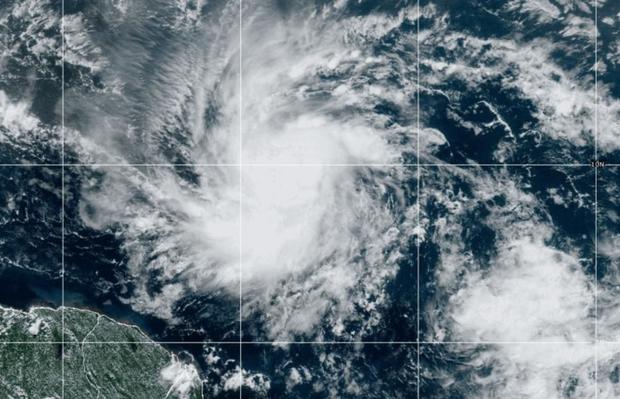
Beryl strengthens into a Category 1 hurricane in the Atlantic as it bears down on Caribbean
Beryl strengthened into a hurricane on Saturday as it churned toward the southeast Caribbean, with forecasters warning it was expected to strengthen into a dangerous major hurricane before reaching Barbados late Sunday or early Monday.
A major hurricane is considered a Category 3 or higher, with winds of at least 111 mph. At the moment, Beryl is a Category 1 hurricane.
A hurricane warning was issued for Barbados, and a hurricane watch was in effect for St. Lucia, Grenada, and St. Vincent and the Grenadines, while a tropical storm watch was issued for Martinique, Dominica and Tobago. Hurricane watches were in effect for Barbados, St. Lucia, Grenada, and St. Vincent and the Grenadines, while a tropical storm watch was issued for Martinique, Dominica and Tobago.
NOAA
More than fifty years have passed since a hurricane appeared before July 4th in the Atlantic basin. Alma hit the Florida Keys on June 8, 1966, according to Weather Underground.
busy hurricane season, which runs from June 1 to Nov. 30 in the Atlantic. Last week, Tropical Storm Alberto brought torrential flooding to portions of southern Texas and northeastern Mexico. It was responsible for at least four deaths in the Mexican states of Nuevo Leon and Veracruz.
According to CBS News weather producer David Parkinson, Beryl is the farthest east a hurricane has formed in June, and one of only two to do so east of the Caribbean, with the other instance occurring in 1933.
Parkinson expects Beryl to remain south of Jamaica, and forecasts that any U.S. impacts are still at least eight days away.
Beryl’s center is forecast to pass about 26 miles south of Barbados, said Sabu Best, director of the island’s meteorological service’s director.
On Saturday, Beryl was located about 720 miles east-southeast of Barbados, with maximum sustained winds of 75 mph. It was moving west at 22 mph.
“Rapid strengthening is now forecast,” the Miami-based National Hurricane Center said.
Atmospheric science researcher Tomer Burg noted that Beryl was just a tropical depression with 35 mph winds on Friday.
“This means that according to preliminary data, Beryl already met rapid intensification criteria before even becoming a hurricane,” he wrote on X.
Warm waters are fueling Beryl, with ocean heat content in the deep Atlantic the highest on record for this time of year, according to Brian McNoldy, University of Miami tropical meteorology researcher.
Beryl also is the strongest June tropical storm on record that far east in the tropical Atlantic, according to Klotzbach.
“We need to be ready,” Barbadian Prime Minister Mia Mottley said in a public address late Friday. “You and I know when these things happen, it is better to plan for the worst and pray for the best.”
She noted that thousands of people are in Barbados for the Twenty20 World Cup cricket final, with India beating South Africa on Saturday in the capital of Bridgetown. It is considered cricket’s biggest event.
Some fans, like Shashank Musku, a 33-year-old physician who lives in Pittsburgh, were rushing to change their flights to leave before the storm.
Musku has never experienced a hurricane: “I don’t plan on being in one, either.”
He and his wife, who were rooting for India, found out about Beryl thanks to a taxi driver who mentioned the storm.
Meanwhile, St. Vincent and the Grenadines Prime Minister Ralph Gonsalves said in a public address Saturday that shelters will open Sunday evening as he urged people to prepare. He ordered officials to refuel government vehicles, and asked grocery stores and gas stations to stay open later before the storm.
“There will be such a rush …if you keep limited hours,” he said as he apologized ahead of time for government interruptions on radio stations with storm updates. “Cricket lovers have to bear with us that we’ll have to give information … this is life and death.”
Beryl is the second named storm in what is predicted to be a busy hurricane season, which runs from June 1 to Nov. 30 in the Atlantic. Earlier this month, Tropical Storm Alberto came ashore in northeast Mexico with heavy rains that resulted in four deaths.
Lowry noted that only five named storms on record have formed in the tropical Atlantic east of the Caribbean. Of those, only one hurricane of record has formed east of the Caribbean in June.
Mark Spence, manager of a hostel in Barbados, said in a phone interview that he was calm about the approaching storm.
“It’s the season. You can get a storm any time,” he said. “I’m always prepared. I always have enough food in my house.”
Beryl is expected to drop up to six inches of rain in Barbados and nearby islands, and a high surf warning of waves up to 13 feet was in effect. A storm surge of up to seven feet is also forecast.
The storm is approaching the southeast Caribbean just days after the twin-island nation of Trinidad and Tobago reported major flooding in the capital, Port-of-Spain, as a result of an unrelated weather event.
Meanwhile, a no-name storm earlier this June dumped more than 20 inches of rain on parts of South Florida, stranding numerous motorists on flooded streets and pushing water into some homes in low-lying areas.
According to the National Hurricane Center, the season’s first hurricane usually forms in early to mid-August, which makes Beryl unusual for reaching hurricane strength. In a report released last month, the NOAA predicted an “above average” hurricane season with 17 to 25 storms, 8 to 13 hurricanes and 4 to 7 major hurricanes of category 3 or higher.
A tropical storm is a tropical cyclone with maximum sustained winds of 39 to 73 mph, while a hurricane is defined as a tropical cyclone with maximum sustained winds greater than 74 mph.
Source: cbsnews.com